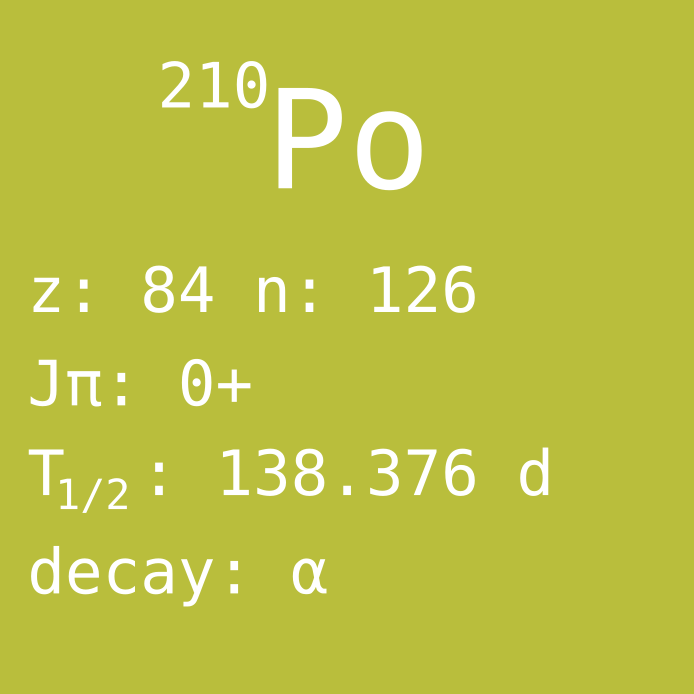

Yesterday, we presented a non-toxic reactor poison, today we will have a look at another kind of poison, a toxic non-reactor poison. With that complicated presentation, it’s our pleasure to introduce polonium-210. Once again, a nuclide that like radon-222 may not be very likeable, but it is still a bit interesting to learn more about.
Po-210, with 84 protons and 126 neutrons, exists only in trace concentrations in nature, and it was one of the nuclides in the uranium decay series that were discovered by Marie Curie. (The element was named after her native home Poland, which was not an independent country at the time). There is no isotope of polonium that is stable, and Po-210 is one of its longest lived isotopes. Although Po-210 occurs in nature in trace amounts, it is not feasible to extract it, thus for practical applications it is also produced in nuclear reactors by irradiating Bismuth-209.
Po-210 has a half-life of not much more than hundred days, and it decays with an energetic alpha decay. Therefore it produces a lot of heat, which has found use for heating electronics in probes in the cold lunar night. Also, the alpha decay makes it possible to use as a neutron source, if infiltrating an element with low atom number, typically beryllium. The alphas can knock loose neutrons from the lighter element.
But we have to also mention the elephant in the room now, Po-210 has been used as a murder weapon, because it’s a deadly poison if ingested, even in very small amounts. Infamously, it was used against defector Alexandr Litvinenko. While the alpha radiation is not very harmful when a person is exposed externally, it is indeed very toxic when inhaled or ingested. Litvinenko did consume Po-210 while enjoying his cup of green tea which was previously spiked.
Many other nuclides that decay by alpha emission would enter an excited state of the offspring nucleus, causing further gamma decays in a cascade of emitted radiation. On the contrary, Po-210 almost always decays to the ground state of the offspring (stable lead-206), therefore it is more difficult to detect. Gamma emitters are generally much easier to detect by a radiation monitor, than the alpha that is easily shielded by a container. In fact, there is still a little emission of gamma rays joining the alpha, but it’s only from one in a thousand decays that a single gamma ray at 803 kilo-electronVolt is emitted. One can speculate that this could be the reason why it was used as a murder weapon, because it could be transported across borders without great risk of detection? However, in the case of Litvinenko’s murder, this little signal at 803 keV was still enough to be identified in gamma spectroscopy, which directed suspicion towards Po-210. Either the investigators might have been lucky, or they did a thorough investigation of the radiation spectrum.
Now, if you are also a defected secret agent, you might already be looking out for polonium exposure. But note that just because you are not a secret agent, that does not mean that you are totally safe from exposure. In fact, natural sources of polonium might reach unhealthy levels. In particular, it is known that polonium is accumulated in tobacco plants. Therefore, any habitual smoker will over their lifetime receive substantial radiation dose to their lungs from the alpha radiation of Po-210. Still, it’s probably not the worst toxin that the smokers expose themselves to. So as a final advice to our readers, don’t smoke.

© 2020 Zs. Elter, P. Andersson and A. Al-Adili